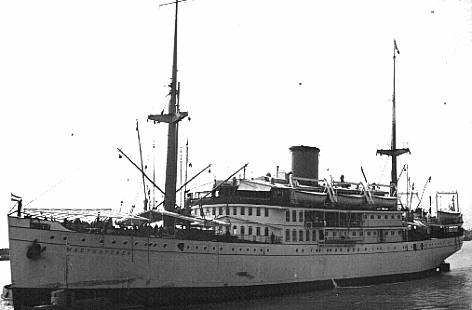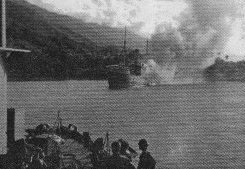The war in New Guinea was one of the toughest ever fought in the annals of military history.
From early 1942 to the last day of the war, Japanese and Allied troops ( mainly Australians )
fought fiercely to preserve their territory. They were supplied by a vast stream of smaller
steamers, Dutch, Australian and also some Americans. Especially the first have played a large, yet
unknown role in the history of this battleground. This article will tell the story of these
brave, Dutch small ships.
By early 1942, the Japanese had settled in the most part of the eastern Netherlands East
Indies, including a part of New Guinea. They moved southwards and occupied several smaller
islandgroups near Australia, and then shifted their attention to the east: The Solomons and
the rest of Nieuw Guinea. Nieuw Guinea was, and still is, a terrain where humans have to
deal with extremely bad weather and dangerous animals. It's about 2400 kilometres from
"head to toe" and looks like a prehistoric bird that's trying to eat Celebes.
The Japanese first occupied ports in the north of Nieuw Guinea (Sorong and Hollandia for example) without much trouble. They
then planned an assault on Port Moresby, which could be done in two ways: First of all, a
direct sea-attack with all the strength the Japanese could scrape together. Second, an
attack over land from Buna in the north to Port Moresby on the southcoast, right through
the thick jungle. Fortunately, the sea-assault failed with the strategical defeat in the Battle of the
Coralsea, costing the Japanese one carrier and damage to two others. Things had to be done the hard way.
In order to be able to use Port Moresby, The Japanese had to be sure that the shipping lines could be operated without interference. To do that, Japanese forces would have to conquer whole New Guinea, or at least large parts of it, especially the coastal regions where airfields could be built. There was a large bay on the very eastern tip of the island, Milne bay, that would become one of the most important areas of New Guinea. The Japanese knew, they would have to invade Milne Bay to control the West Solomonsea.
The local Commander-in-Chief, General Douglas MacArthur, was one step ahead of them when he landed
the first Australian troops ( 1 infantrycompany and an AA-detachment ) in early June 1942 at Gili Gili with
the Australian freighter ss Islander. Soon, more troops arrived and they made a start with
an airfield to provide cover in the air, but they badly needed supplies and equipment for
the task at hand.
 |
Maetsuycker
She was a 4131 ton gross weight passenger ship of the KPM, dating from 1937. She first served in the New Guinea supply run, but was in 1944 converted to a hospitalship for the British Eastern Fleet and survived the war. She was scrapped post-war. |
The most suitable ships for these circumstances were without a doubt the ships of a Dutch
shipping line, the Koninklijke Paketvaart Maatschappij, usually known as the KPM, which had
a monopoly on the lines connecting the various islands of the Netherlands East Indies.
They usually had 1000-6000 ton ships for several larger lines, and those were perfectly
suitable for the hot climate. A large number of these ships were lost in the Netherlands East Indies, but many survived by
escaping to the British Indies or Australia. They had already been useful in supplying Port Moresby and other islands with
supplies, but their finest hour was still in New Guinea. The first ships to arrive were the
Bontekoe and Karsik, later followed by ships like the Maetsuycker, Cremer, Van Heemskerck and
many others, also from other nations like the Australian Taroona, Katoomba and Duntroon, and
the American West Cactus and Bushnell. The naval authorities had to work with what they had,
since the battle of the Atlantic demanded the most immediate attention for the American dockyards. The famous Liberty- and Victory-ships weren't available in the first years of war. To increase their numbers, six KPM-ships were rerouted to Australia during 1942.
In June 1942, the ss Tasman succeeded in bringing parts of the 7th Australian infantrybrigade
to New Guinea, In August 1942,
the Bantam ( 3322 tonnes ) together with the ss Cremer ( 4608 tonnes ) and a British ship,
put the 18th Australian brigade under general Clowes, with HQ and all ashore in Milne Bay, four days before the Japanese
invaded from sea in the night of the 24 to 25th. Fortunately, the Japanese numbers were diminished by allied air attacks and the fierce Australian resistance. By early September, all Japanese were driven off the island and by October 1942, the supply-route was operating as effective as never before. The KPM-ships alone were
responsible for 70.000 tons of the total amount of supplies delivered in to the fronts in
New Guinea. That number was equal to about 62 % of the total. The supplies were delivered
to quickly constructed pontoons of oilbarrels, wooden rafts and bamboo, tied together with
strings of rope. When the first so-called Liberty pier was completed, the 4100-tonnes
Maetsuycker was the first to moor alongside. In December 1942 as war progressed in favour of the Allied, the Karsik ( the former German
Soneck of the D.D.G. Hansa ), together with the Japara landed an Australian tank-unit near
Buna, which was in a place where no ships of that size had operated before. Despite the
counterattacks with aircraft, atillery and infantry, they both sailed away unharmed.
Unfortunately, a campaign, not harassed by the large Japanese planes or ships was
too much too hope for, and several larger ships paid the price. In the early fase, it usually
went well. An example was the trip the Tasman ( 5172 tonnes gross weight, 1922 ) made with the
brandnew Australian destroyer HMAS Arunta. They were in Gili Gili, when a Japanese air attack
in the morning of the 1st of september almost put an end to their careers. They then had to
hastily leave Milne Bay, when recon reports indicated a second Japanese attack from the sea.
They left immediately, and hid between the islands of the China Strait, only to come back in
the morning to unload the cargo. Another example was the Van Heemskerk, which was damaged in an
air attack in December 1942. So as 1942 was a rather succesful year for the KPM, 1943 was far
more unpleasant.
After escaping numerous times, the KPM-ships finally had to give up one of their own. On
March 28 1943, the Bantam ( 3322 gross weight, 1930 ) was unloading in Oro Bay, but was disturbed by two Jap divebombers which straddled the ship with several near misses. Although she
wasn't hit directly, the fragments and air pressure caused damage to several steampipes
in engineering and petrol-loaded lighters alongside. They also caused several fires, which did
serious damage on board. After the crew had fought the flames and she was towed to a place
where she was out of the way, she had to be abandoned. After another hit placed in the
steering cabin by bombers during the night, she was a total loss. Luckily, there were no casualties.
The 's Jacob, dating from 1907 and
with a displacement of 2484 gross weight, was another veteran of the Milne Bay runs. She became the victim of nine high-flying bombers on the 8th of March. She was on her way from
Milne Bay to Oro bay, and was about 120 miles east of Port Moresby. Three direct hits and at
least 15 near misses caused serious damage and several heavily wounded aboard. Besides the crew,
there were 72 other passengers on board. There was a large fire on the foreship ( where two
bombs had crashed through the deck ), but all effort was futile. At one point the pumps
shut down and without any way to fight the flames, the only way to go was to abandon ship.
Because three of the sloops were destroyed, all had to jump overboard, but were picked up
by the Australian corvette Bendigo. Eighteen minutes after the attack, the waves closed over
the old ship and 5 crewmembers.
The last victim was the Van Heemskerk, also a rather old ( 1909 ), but sturdy steamer of 2996 tonnes
gross weight. She was damaged in late 1942, but repaired in Brisbane to take her place in the
lifeline. She was near Port Moresby with another KPM-ship, the Balikpapan. The town was under
heavy air attack by over a 100 Japanese bombers. They were redirected to Milne Bay, where they
arrived safely on April 14, 1943. They hastily unloaded the troops, as a yellow flag announced
the immediate threat of air attack. Soon, the yellow flag was replaced by a red one, indicating
that the air attack could take place at at any moment. The Van Heemskerk and Balikpapan, together with the Van Outhoorn were ordered to leave the bay as quickly as possibly. Soon the
air attack began, and especially the Van Heemskerck and Balikpapan received much attention from the Japanese. The Van Heemskerk escaped four "skip-bombing" attackes, but she was
heavily damaged by the near-misses, even though Colt machineguns mounted on Jeeps fired as quickly
as they could. The damage was serious, and so was the number of wounded aboard the ship.
A heavy explosion in one of the cargo holds, no IV, caused heavy fires.
It was filled with all kinds of cargo, including ammo and the heat caused the decks to turn red and curle up. Ammo crates and patroleumbarrels exploded, but an Australian corvette came alongside and put her damage control crew aboard. After the fire had reached cargo hold no II and engineering was out of service, the crew abandoned ship. She was beached on a coastal reef, and later slipped of it into the deep. Four crewmembers died in this tragedy.
| Van Heemskerck hit by bombs. Picture was taken from the Australian corvette Wagga, which came to her aid. |
 |
The battlegrounds on New Guinea became a secondary priority for both the Allies and the Japanese after 1943, but in 1942 and 1943 the KPM-ships alone carried about 100.000 troops to
the front, along with about 1 million tonnes of tanks, trucks, gasoline, bombs and ammo. Colonel Burns, the commander of the troops in Milne bay later stated: "The arrival of the first of many ships which defied the Coralsea and the uncharted, unbeaconed China Strait, can considered to be the turning point in the history of Milne Bay and the first victory over the Japanese. Never will I forget the Heemskerk, Maetsuycker, Van Heutsz, Tasman and all the other brave ships". |
![]()
![]()
![]()
![]()